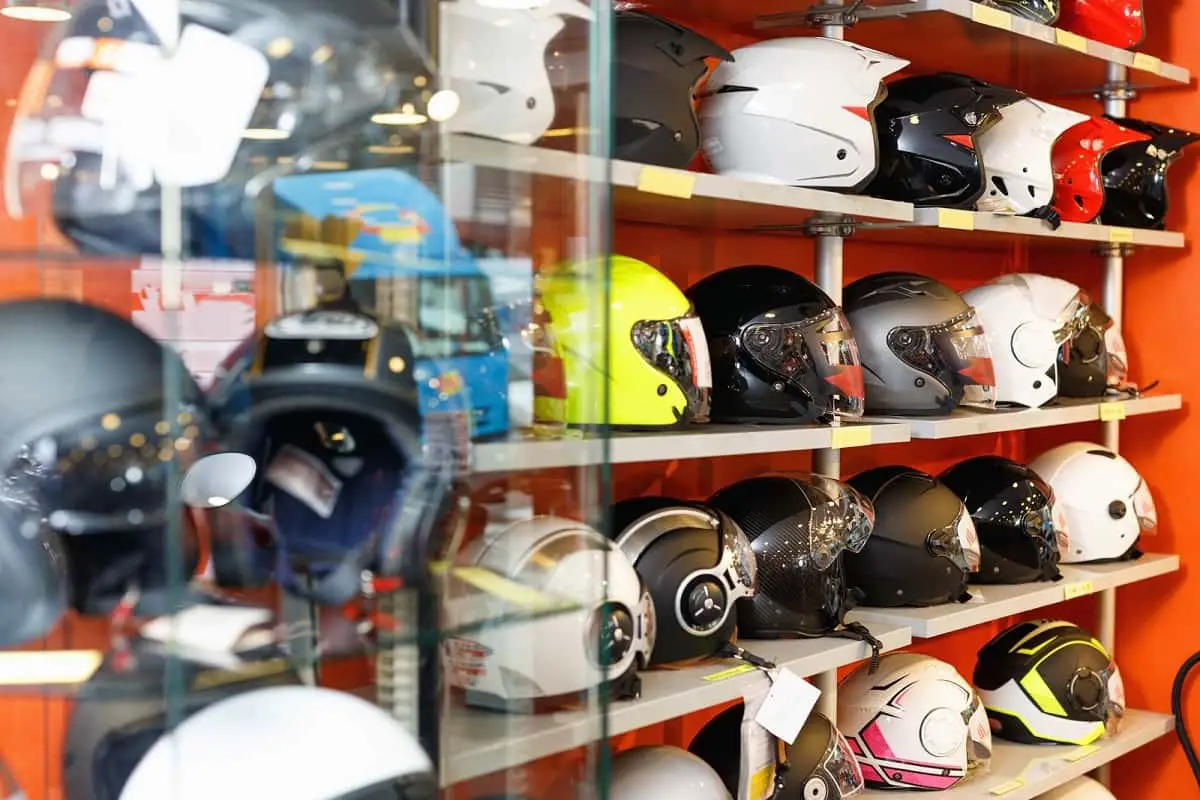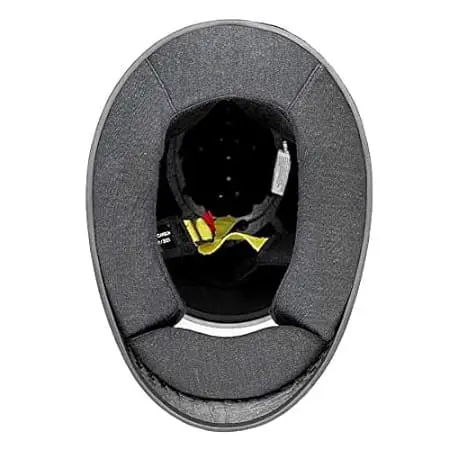What Are Motorcycle Helmets Made Of?
When speaking to salespeople in motorcycle accessory shops, you may have been baffled when they started telling you about thermoplastics, EPS layers, and so on in their attempt to describe why one helmet was better than another.
What are motorcycle helmets made of, won’t be a concern anymore as this article is going to cover all you need to know.
No longer will you be left scratching your head wondering about the difference between thermoplastics and composite shells, and when you finish reading you will know what an EPS liner is and how it fits into the grand scheme of things.
You will then be in a position to make an informed decision about which helmet best suits your needs and budget. Knowledge is power.
KEY TAKEAWAYS
* A variety of materials are used for the outer shell: polycarbonate, ABS, fiberglass, carbon fiber, and Kevlar.
* Helmet prices are largely affected by the materials used for the outer shell.
* The inner foam liner is made from EPS (Expanded Polystyrene) for its shock absorbing qualities.
* The comfort liner is usually made from cotton/polyester.
* The chin strap is usually durable nylon with a double D-ring or a buckle.

Disclosure: As an Avantlink and Amazon Associate, we earn from qualifying purchases. Disclosure Statement.
Page Content
What Are Motorcycle Helmets Made Of?
Motorcycle helmets come in a variety of materials that each manufacturer will deem safe in the event of a crash. Around the world, there are various governing bodies that test helmets and manufacturers have to meet certain standards in order to be produced and sold.
The best thing a helmet can do no matter what material is used is to absorb the kinetic energy caused by an impact and keep it away from the rider’s skull. Different materials do this in different ways.
SUGGESTED: Motorcycle Helmets For Big Heads
There are cheap and expensive helmets, the price of which is largely affected by the materials used for the outer shell. For example, polycarbonate shells are very common and tend to be cheaper than composite shells, but that is not to say they don’t serve a purpose.
It isn’t just the shell material to consider but the rest of the motorcycle helmet material too like the inner foam liner, comfort liner, chinstrap, and visor.
How Are Motorcycle Helmets Made?
Depending on the motorcycle helmet material selected there are different processes for producing a helmet. The biggest element that affects the manufacturing process is the material for the shell.
The most common types of motorcycle helmets are those composed of ABS or polycarbonate, they are also the cheapest. This is because they are thermoplastics, which means they can be heated up and molded around a head-form, which is a fairly quick process and makes them suitable for mass-production on a large scale.

Many helmet brands actually share the same factories for their thermoplastic helmets, and the helmets are just branded a bit differently or have an extra feature added.
Composite helmets are made up of a mix of all or some of the following: fiberglass, carbon fiber, Kevlar/Dyneema, etc. and are more complicated to produce and many are done by hand.
As the name suggests the shell is composed of various materials which are weaved in a tight-knit together and then shaped into the helmet form. This is a long and difficult process which is why composite helmets are more expensive.
This content was originally published on headsdontbounce.com. If it appears on another website, it is a violation of the copyright owned by headsdontbounce.com.
It is common for a helmet brand to have a mix of thermoplastic and composite shells in their line-up to account for all price points.
RECOMMENDED: Best Modular Motorcycle Helmets
What you will find as well, during the manufacturing process cheaper plastic helmets will have a range of sizes but perhaps only 1 or 2 shell sizes. To make up the different sizes, the inner comfort liner padding is increased or decreased. Whereas, generally, composite helmets will come in a range of sizes and have more shell sizes providing a much better fit.
Let’s have a look at what materials are used to construct helmets in more depth.
Motorcycle Helmet Shell
Motorcycle helmet shells tend to be separated into two categories Thermoplastics and Composite; within those two umbrella titles, there are a few more variants. The helmet shell is the most important part of the construction followed by the EPS liner (motorcycle helmet padding material).
Thermoplastics
Under the branch of thermoplastics lies two main types of plastic material: ABS and polycarbonate.
ABS is a harder, heavier, more brittle but cheaper plastic.
Note with the two examples above that they are very similar looking open-face helmets and yet the polycarbonate is slightly more expensive.
Both are thermoplastics which means they are heated up to be molded and can be widely mass-produced quickly; which is why they are cheaper than composite shell helmets.
RELATED: German Style Motorcycle Helmets
With manufacturers using thermoplastics you will likely see a lot of different paint schemes and maybe additional features such as an extra vent, or inner speaker cutouts, but underneath, the shell, across the board, will be the same.
However, don’t be fooled as some brands such as Bell, one of the leading helmet manufacturers, produce helmets that are thermoplastic but have similar helmets that are composites. By doing this it allows them to sell their thermoplastic lids at more expensive prices slipping under the radar.
Composites
When it comes to Composite shells, things can get a bit more complicated. Depending on the manufacturer and their research/design and testing processes, the actual composite material can be made of various materials.
The main materials used in a composite shell are:
- Fiberglass
- Carbon Fiber
- Kevlar/Dyneema/Aramid
- SRS (Synthetic Reinforced Shell)
Some manufacturers are very vague about what actually makes up their composite shell, some just saying fiberglass, other composites, etc. Whereas sometimes they will provide great detail about what makes up the shell.
Essentially, how much it matters what the helmet material is made up of, is up to the consumer, as long as it protects your head and does its job, it may not matter at all.

Essentially fiberglass, carbon, kevlar, and any other material used to make the composite are laid out and then carefully weaved together to provide strength all the way around the helmet. This is done with several layers of the weaved material and then the helmet is molded to shape.
Something to be aware of is that there are some helmets out there that are made mostly of carbon fiber which make them not only very strong but very lightweight and in recent years these have become very popular options, such as this Scorpion helmet.
Shark and Bell are two brands that also produce solely carbon fiber helmets. These types of helmets tend to be some of the most expensive.
SUGGESTED: What To Do With Expired Helmets
Another popular feature lately has been helmets with carbon fiber skin. This is essentially a wrap over the helmet to look like carbon when in fact it is not, and underneath is likely a fiberglass/composite shell.
ABS Plastic Vs Fiberglass
The key differences between ABS plastic and fiberglass shells are as follows:
- Weight – Plastic shells are heavier
- Price – Plastic shells are cheaper
- As a general rule, Fiberglass can come in more shell sizes, which make for a better fitting helmet
Fundamentally the biggest difference between the two is how they respond to an impact.
Thermoplastic shells like ABS are built to be strong, unlikely to dent or flex, and built to withstand penetration. This was based on the original old school belief that a hard helmet will protect the head in an accident.
However, composite shells like fiberglass react differently to this. The outer shell will, by design, flex on a minor impact but often shatter on a hard impact. This is so that the energy from the impact is dispersed around the helmet rather than transferred to the skull.
It is not dissimilar to some new cars that have buckle points that cave in upon an impact as they absorb the energy.
SUGGESTED: Motorcycle Helmet Communications Systems
However, carbon fiber shells will tend to flex rather than shatter, thus offering better overall protection in a hard impact. The carbon fiber shell also being lighter than fiberglass, therefore, justifying its higher price tag.

If you think of a textile weave and then lay another weave on top and another until there are several layers of weaved material; that is how a composite shell is constructed. There are several layers the kinetic energy must pass through before reaching the inner liner and then the skull.
Inner Foam Liner
The motorcycle helmet padding material is commonly known as EPS – Expanded Polystyrene.
This liner is the next layer under the outer shell. Essentially polystyrene beads are poured into a mold, steam and a blowing agent called pentane is applied and the beads expand fusing together into one mass.
It is lightweight, works in various climates and conditions, and therefore is perfect for motorcycle helmets.
The EPS liner is a big part of the impact energy absorption process. It is very effective at reducing the energy from an impact transferring to the head. Essentially some of the kinetic energy is converted into heat and the transmission of energy is slowed down and therefore less damaging.
On impact, the polystyrene beads crush to absorb the energy. This is why helmets are really only good for one impact and why it is recommended that should a helmet be involved in an accident, you replace it as the EPS liner doesn’t repair or blow back up, thus leaving a weak spot in the helmet.
When helmets have composite shells on the outside, in the various shell sizes the EPS liner will be adapted to different thicknesses too for the best protection. On cheaper helmets, the EPS liner is standard like the shell, and it is the comfort liner that is thicker or thinner to determine size.
IMPORTANT: How to Know Your Helmet Size
This can mean a person with a large head will wear a helmet with thinner EPS relative to their size/weight and thus not have the best protection in the event of an accident.
In some cases, the EPS liner is cut into by the manufacturer for the helmet to receive features like internal sun visors or headsets. However, Arai has refused to fit an internal visor on the basis that they have concern that it interferes with the integrity of the EPS.
Comfort liner
The other type of motorcycle helmet padding material is the comfort liner which adheres to the EPS liner. This has no real safety features and is solely comfort-based.

The liner can be made of various materials including cotton/polyester or a combination and many have sweat-wicking properties to keep you cool and dry.
The padding itself is usually just a foam that will compress to keep you snug when you wear the helmet and bounce back when not in use.
The comfort liner can be shaped to accommodate eyeglasses and headset speaker pockets. Unlike the EPS foam liner, the comfort liner is often removable and washable.
SUGGESTED: Are White Motorcycle Helmets Safer?
Chinstrap and Buckle/D-ring
With a motorcycle helmet, the chin strap will be made of nylon that is super durable and resistant to various temperatures and conditions.
Attached to the strap will be either a buckle closure like a ratchet system made of plastic or a metal D-ring closure.
The D-ring closure is the one deemed the safest by racing authorities, due to its strength in the testing of high-speed impacts.
You will likely find a tough plastic buckle closure on modular helmets, which riders will presumably be more likely riding touring/commuting bikes rather than sports bikes.
Visor
Motorcycle visors are made of one of two things: Acrylic or Polycarbonate.
Cheaper helmets will use acrylic, which is brittle, scratches easily, is lightweight, and inexpensive.
Polycarbonate visors are more durable, flexible, and more expensive. Polycarbonate visors are the most common type of visors used in the industry.
Summing Up
Although most motorcycle helmets look much the same on the outside, you now know that there can be a lot of variables that go into the composition of different motorcycle helmets. You also know why two similar-looking helmets can have such a big difference on the price tag. And, you also know why some helmets fit better than others.
You can now take this new found knowledge and purchase a helmet with the confidence that you know exactly what you’re getting.

Frequently Asked Questions
Q. What is the best material for a motorcycle helmet?
A. Everybody will have a preference when it comes to the material their helmets are made of. Personally, composite shells are the ones that I think are the best thanks to the research that has gone into impact absorption. I have a bad neck too, so lighter weight helmets are my preference.
Ultimately, material, price, design, etc. is not as important as wearing a helmet that fits properly.
Regardless of anything including whether your helmet is fiberglass or thermoplastic, the one that fits the best is the one for you. It is always recommended to go and try on as many helmets as possible to get the right size.
SUGGESTED: Can You Use A Bicycle Helmet On A Motorcycle
Q. Are motorcycle helmets bulletproof?
A. No, motorcycle helmets are not bulletproof. While some composite shells will have Kevlar in them which is used in bulletproof and stab-proof vests, they are not completely made up of the material or any other strengthening bulletproofing material.
However, some test procedures require an air-rifle pellet to be fired at the helmet to test its strength against penetration. The idea is that this replicates a situation where rubble, stones, etc fly up off the road and hit the helmet.
Q. Are fiberglass helmets safe?
A. Yes. Early on in helmet production, they used to be made of fiberglass which was traditionally very brittle, strong, not unlike thermoplastics (but without the flex) and these would shatter completely in impacts. It was soon determined these were not fit for purpose as technology developed.
Today’s fiberglass helmets are often made up of different composites with other materials and the term ‘fiberglass’ is often used interchangeably with ‘composite’ which confuses people. The fiberglass material and manufacturing process today, is designed to flex and absorb the impact.
If unsure be sure to look up the manufacturer’s website and they should list the helmet’s material.
I hope we have covered the question of ‘what are motorcycle helmets made of’ to your satisfaction. If you enjoyed this article, take a look at the related reads below for some more interesting reads!
Related Reads:



